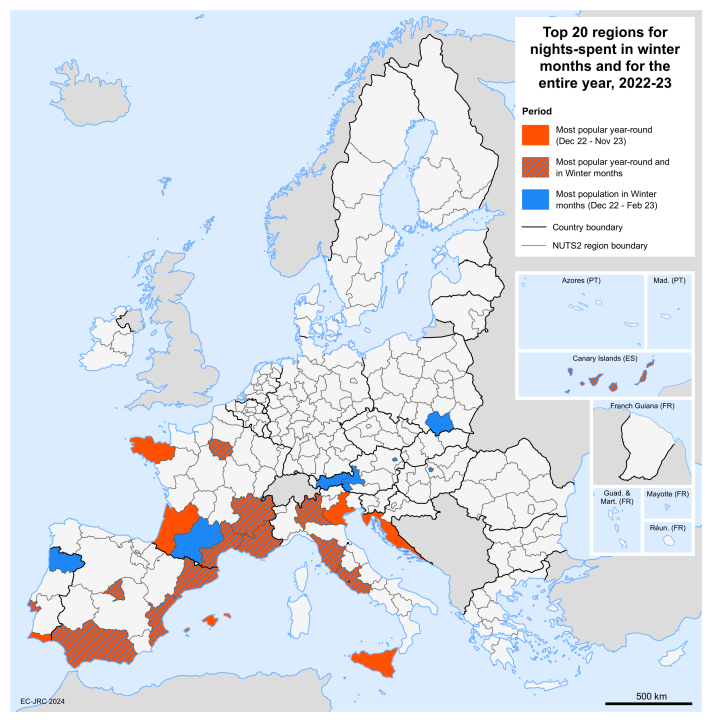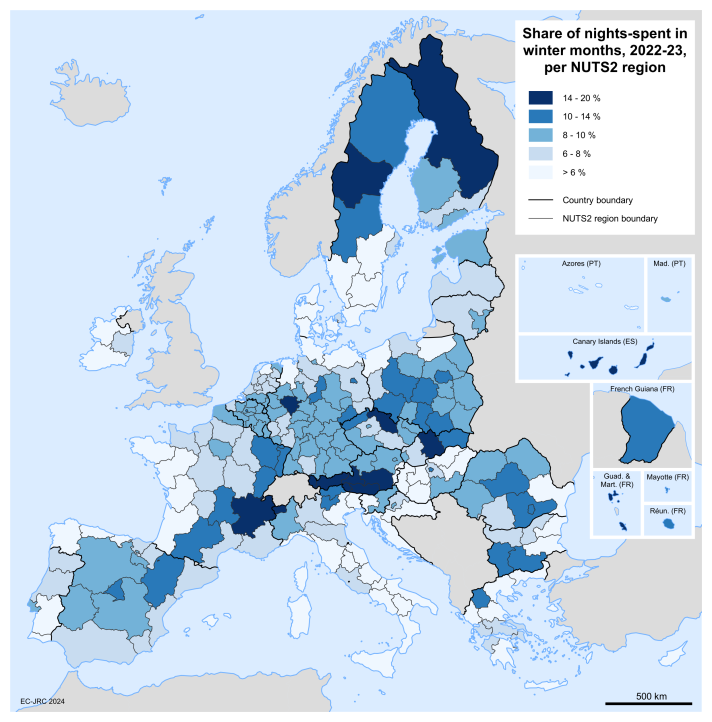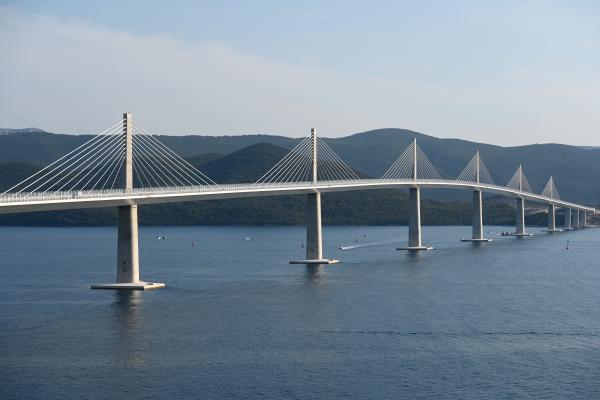
Data from the EU Tourism Dashboard show that in winter, southern coastal regions are the EU’s travel hotspots. The dashboard shows the latest data (available until the end 2023) and indicators on EU’s tourism ecosystem at national, regional and sub-regional levels.
Looking at the total number of nights spent during winter over the period December 2022 - February 2023, five Spanish regions rank in the top 10, with the Canary Islands emerging as the most popular destination, surpassing 6 million nights-spent.
Rhône-Alpes in France, not only noted for its high concentration of winter stays but also for its winter popularity, ranks second with 5.8 million. Spain’s Andalusia follows, exceeding 5 million nights-spent, while Île-de-France records 3.8 million. Catalonia in Spain and Provence-Alpes-Côte d’Azur in France reported just under 3 million nights each, with Valencia reaching 2.3 million.
Tyrol in Austria, recognised for both its winter seasonality and total nights, recorded 2 million stays. Completing the top 10 are Lazio, Italy, and Madrid, Spain, each with approximately 2 million nights-spent during the winter season. Top 20 regions confirm the trend, although some snow and capital-city destinations in Central Europe make it to the list.
A peak season in winter?
With the arrival of winter, many regions experience their peak tourist season. In Tyrol, Austria, a renowned winter sports destination, 20% of annual overnight stays were recorded between December 2022 and February 2023. Salzburg, Austria, and Valle d'Aosta, Italy, follow closely with each attracting 19% of their yearly nights-spent within this period.
Unsurprisingly, aside from the top three regions, the majority of the remaining top 10 destinations are mountainous areas popular for winter activities. These include Pohjois- ja Itä-Suomi in Finland (17%), two Swiss regions—Ostschweiz and Région lémanique (both with 17%)—as well as Steiermark and Vorarlberg in Austria (17% each), Stredné Slovensko in Slovakia (16%), and Rhône-Alpes in France, also at 16%.
Which destinations attract most tourists over the entire year?
According to the dashboard, in 2023 Mallorca was the most visited region, recording over 51 million overnight stays, followed by Paris, with nearly 44 million, and Rome with 41 million.
Berlin, Croatia’s Istria peninsula, Amsterdam, and the Greek Cyclades islands recorded between 25 and 29 million overnight stays in 2023. Significant increases compared to 2019 (between 5.5 and 3.1 million overnight stays) were recorded in Copenhagen, Ireland’s second largest city Cork, Munich, the Lanzarote Island, Porto, and the French region of Seine-et-Marne.
Tourism intensity and seasonality
Two measurements are particularly relevant to determine the economic relevance of tourism in a given destination:
- tourism intensity: number of nights spent at tourist accommodations divided by the resident population
- tourism seasonality: number of nights spent in the three most visited months in relation to the total nights spent.
Looking at EU countries, tourism intensity in Croatia, Malta and Cyprus is significantly higher than the EU27 average (22 to 20 nights compared to 6 nights per resident). In addition, tourism seasonality is particularly high in Croatia (74%), Bulgaria (59%) and Greece (59%). Such high values indicate that tourism is a significant part of their economies, but also makes these countries more vulnerable to sudden shocks in the sector.
Values for 2023 show that Germany, Greece, Italy, France, Spain, Austria and Croatia host the majority of the 100 EU regions with the highest tourism intensity values, with an average of 44 nights spent per resident against the EU average of six. Peaks of 145 to 115 nights per resident were registered in the regions of Corfu (Greece), Istria (Croatia), South Aegean (Greece), and Fuerteventura and Lanzarote (Spain). These figures suggest that southern coastal regions rely heavily on tourism to sustain their economies.
Regarding seasonality, the South-eastern Bulgarian coastal region concentrates almost 80% of its nights spent in the 3 most visited months. Values above 70% can also be found in other coastal regions, Croatia, Finland, Romania, Greece and Hungary.
Factoring in tourism typologies emphasises even more the over-dependency of certain locations on the industry: in snowy mountains and coastal regions, nights spent at tourist accommodations are more than twice the EU average. While seasonality cannot be completely avoided due to weather variability and holiday calendars, it can contribute to economic instability and vulnerability when it is excessive.
EU capitals continue to thrive as holiday hives
Capital regions play a crucial role in attracting tourists, accounting for approximately 26% of nights spent in tourist accommodations across the EU in 2023. Paris, Amsterdam, Copenhagen and Prague stand out, with intensity values exceeding significantly the national averages. Alongside Copenhagen, Tallinn and Riga have seen their national tourism share rise by around 10% compared to 2019.
In addition, nine capital regions (Nicosia, Luxembourg, Valletta, Riga, Tallinn, Budapest, Prague, Vilnius, Copenhagen) account for more than 30% of tourism nights in their respective countries.
Paris and Madrid are among the top 20 winter destinations, likely due to their status as two of Europe’s largest and most iconic cities. These cities are major cultural, economic, and tourist centres attracting visitors throughout the year, regardless of the season. Vienna, also among the top 20, is famous for its Christmas markets and classical music events, while Budapest boasts world-known thermal baths, festive markets and affordability compared to other major European cities.
While the economic significance of capital cities and regions is evident, capitals are less exposed to economic risks compared to coastal or mountainous regions – where seasonal tourism is the main source of income.
Background
Launched in 2022, the EU Tourism Dashboard was developed by the JRC and the Commission’s Directorate-General for Internal Market, Industry, Entrepreneurship and SMEs, following a request by EU Member States to design a tool for monitoring the twin transition and resilience of the tourism ecosystem. The dashboard is developed in cooperation with Eurostat and in coordination with the EU Member States.
It contributes to the Transition Pathway for Tourism, created in collaboration with public and private EU tourism stakeholders to identify areas of action for the green and digital transition and for improving the resilience of tourism sector in the EU. The Dashboard is flexible to improvement with new indicators. Taking into account additional factors, such as the number of day-visitors in very touristic places, would allow for even more thorough analyses of the impacts of unbalanced tourism.
Related links
Details
- Publication date
- 20 December 2024
- Author
- Joint Research Centre
- JRC portfolios






